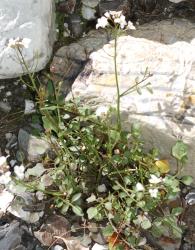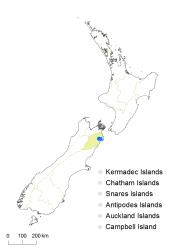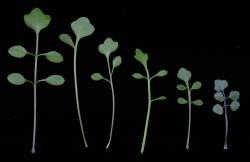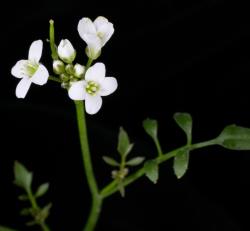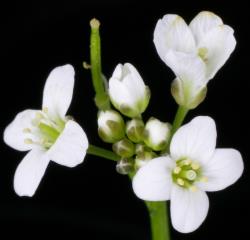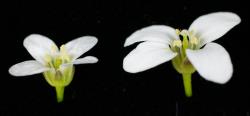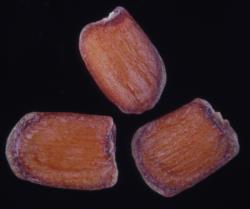Perennial herb, single rosette or with short lateral branches, stem and branches 0.9–2.0 mm diam. Leaves up to 120 mm long, pinnatisect; lamina 30.0–75.0 × 8.0–46.0 mm, green to brown-green, usually semi-coriaceous, glabrous. Terminal pinna 6.0–25.0 × 5.5–22.0 mm, usually simple, orbicular-rhomboid, rhomboid, broadly elliptic-rhomboid to broadly elliptic, often irregularly shaped, apex obtuse with a conspicuous hydathode; margin entire, irregularly and shallowly lobed, with 2 distinct hydathodes; base obtuse to sometimes ± truncate. Lateral pinnae 2–8, 4.0–13.0 × 4.0–9.0, orbicular-rhomboid, rhomboid, broadly elliptic-rhomboid to broadly elliptic, petiolule 2.0–15.0 mm long; petiole up to 60 mm long, glabrous or sparsely hairy toward base. Cauline leaves similar to rosette leaves, but with fewer and narrower leaflets, becoming smaller in all parts; upper leaves 5.0–10.0 × 2.0–3.5 mm, increasingly linear, simple. Inflorescence racemose, usually with lateral racemes, each raceme 4–12‑flowered; peduncle 100–350 mm long, 1.2–2.1 mm diam. at base, spreading to ascending, glabrous. Pedicels 4.0–22.0 mm long, 0.3–0.6 mm diam., glabrous. Sepals 2.4–2.6 × 1.2–1.4 mm, elliptic-oblong to broadly elliptic, saccate, green or red-brown, glabrous, margin white and membranous, apex obtuse, base truncate. Petals 5.0–11.5 × 2.5–5.5 mm, white, limb obovate to broadly elliptic-obovate; apex obtuse; base cuneate to obtuse, tapering to a 1.0–2.0 mm long claw. Stamens 6; median filaments 4, 2.5–4.2 mm long; lateral filaments 2, 2.4–3.5 mm long; anthers 0.7–0.8 mm long, cream to pale yellow, when dehiscent held slightly at a similar height to or slightly below the stigma. Ovary 4.2–4.5 mm long, 0.5–0.7 mm diam., ± terete, green, glabrous; ovules 19–22; style 0.5–1.3 mm long, ± terete; stigma 0.7–0.8 mm diam. Siliques 17.0–40.0 × 1.2–1.5 mm, glabrous, style 0.2–1.4 mm long; valves green at maturity, straw-coloured when dehiscent; replum 0.5–0.8 mm wide. Seeds 1.2–2.1 mm long, 0.8–1.1 mm wide, 0.3–0.4 mm thick, orbicular-oblong to broadly oblong, yellow-brown to henna; wing present at apex and base, especially well developed at apex, 0.1–0.2 mm wide.
Cardamine verna is distinguished from C. alalata by its larger growth habit, matt leaves, terminal leaflet irregularly lobed, lateral leaflets with a longer petiolule, longer inflorescence, larger petals, and larger seeds.
South Island: Marlborough.
Cardamine verna is known from limestone in the vicinity of Ben More and Isolated Hill, in a restricted geographical area between the northern end of the Chalk Range and the lower parts of the Waimā River.
Cardamine verna mainly occurs in river and stream beds among rocks and stones, and on alluvium and rock outcrops.
Cardamine verna is assessed as having a conservation status of Threatened, Nationally Vulnerable B(1), with the qualifier Data Poor (de Lange et al. 2018). The qualifier Data Poor is applied because additional information is required on the number and size of the populations.
Flowering August–December; Fruiting November–April.
There are two flower size morphs in C. verna. The larger flower is up to 13 mm diameter and has petals 7.5–11.0 mm long, median filaments 3.2–4.2 mm long, stigma 0.8–1.0 mm diam., and the stigma protrudes above the dehiscent anthers. The smaller flower has 9–10 mm diameter flowers, petals 5.0–7.0 mm long, median filaments up to 2.7–2.9 mm long, stigma 0.6–0.7 mm diam., and the stigma is placed below the dehiscent anthers. The larger flower and exserted stigma indicate the large-flowered morph may be adapted to outcrossing, whereas the small-flowered morph with the stigma held below the anthers indicates it may be suited to self-pollinating.



